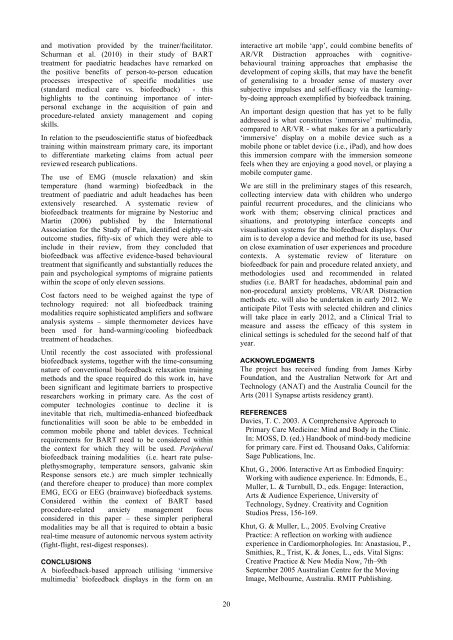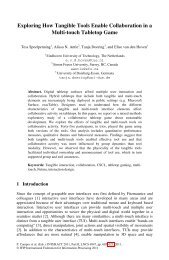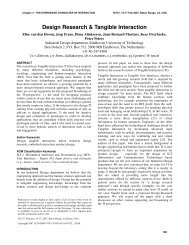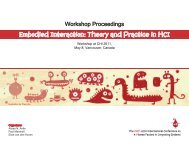Sissy - Elise van den Hoven
Sissy - Elise van den Hoven
Sissy - Elise van den Hoven
You also want an ePaper? Increase the reach of your titles
YUMPU automatically turns print PDFs into web optimized ePapers that Google loves.
and motivation provided by the trainer/facilitator.<br />
Schurman et al. (2010) in their study of BART<br />
treatment for paediatric headaches have remarked on<br />
the positive benefits of person-to-person education<br />
processes irrespective of specific modalities use<br />
(standard medical care vs. biofeedback) - this<br />
highlights to the continuing importance of interpersonal<br />
exchange in the acquisition of pain and<br />
procedure-related anxiety management and coping<br />
skills.<br />
In relation to the pseudoscientific status of biofeedback<br />
training within mainstream primary care, its important<br />
to differentiate marketing claims from actual peer<br />
reviewed research publications.<br />
The use of EMG (muscle relaxation) and skin<br />
temperature (hand warming) biofeedback in the<br />
treatment of paediatric and adult headaches has been<br />
extensively researched. A systematic review of<br />
biofeedback treatments for migraine by Nestoriuc and<br />
Martin (2006) published by the International<br />
Association for the Study of Pain, i<strong>den</strong>tified eighty-six<br />
outcome studies, fifty-six of which they were able to<br />
include in their review, from they concluded that<br />
biofeedback was affective evi<strong>den</strong>ce-based behavioural<br />
treatment that significantly and substantially reduces the<br />
pain and psychological symptoms of migraine patients<br />
within the scope of only eleven sessions.<br />
Cost factors need to be weighed against the type of<br />
technology required: not all biofeedback training<br />
modalities require sophisticated amplifiers and software<br />
analysis systems – simple thermometer devices have<br />
been used for hand-warming/cooling biofeedback<br />
treatment of headaches.<br />
Until recently the cost associated with professional<br />
biofeedback systems, together with the time-consuming<br />
nature of conventional biofeedback relaxation training<br />
methods and the space required do this work in, have<br />
been significant and legitimate barriers to prospective<br />
researchers working in primary care. As the cost of<br />
computer technologies continue to decline it is<br />
inevitable that rich, multimedia-enhanced biofeedback<br />
functionalities will soon be able to be embedded in<br />
common mobile phone and tablet devices. Technical<br />
requirements for BART need to be considered within<br />
the context for which they will be used. Peripheral<br />
biofeedback training modalities (i.e. heart rate pulseplethysmography,<br />
temperature sensors, gal<strong>van</strong>ic skin<br />
Response sensors etc.) are much simpler technically<br />
(and therefore cheaper to produce) than more complex<br />
EMG, ECG or EEG (brainwave) biofeedback systems.<br />
Considered within the context of BART based<br />
procedure-related anxiety management focus<br />
considered in this paper – these simpler peripheral<br />
modalities may be all that is required to obtain a basic<br />
real-time measure of autonomic nervous system activity<br />
(fight-flight, rest-digest responses).<br />
CONCLUSIONS<br />
A biofeedback-based approach utilising ‘immersive<br />
multimedia’ biofeedback displays in the form on an<br />
20<br />
interactive art mobile ‘app’, could combine benefits of<br />
AR/VR Distraction approaches with cognitivebehavioural<br />
training approaches that emphasise the<br />
development of coping skills, that may have the benefit<br />
of generalising to a broader sense of mastery over<br />
subjective impulses and self-efficacy via the learningby-doing<br />
approach exemplified by biofeedback training.<br />
An important design question that has yet to be fully<br />
addressed is what constitutes ‘immersive’ multimedia,<br />
compared to AR/VR - what makes for an a particularly<br />
‘immersive’ display on a mobile device such as a<br />
mobile phone or tablet device (i.e., iPad), and how does<br />
this immersion compare with the immersion someone<br />
feels when they are enjoying a good novel, or playing a<br />
mobile computer game.<br />
We are still in the preliminary stages of this research,<br />
collecting interview data with children who undergo<br />
painful recurrent procedures, and the clinicians who<br />
work with them; observing clinical practices and<br />
situations, and prototyping interface concepts and<br />
visualisation systems for the biofeedback displays. Our<br />
aim is to develop a device and method for its use, based<br />
on close examination of user experiences and procedure<br />
contexts. A systematic review of literature on<br />
biofeedback for pain and procedure related anxiety, and<br />
methodologies used and recommended in related<br />
studies (i.e. BART for headaches, abdominal pain and<br />
non-procedural anxiety problems, VR/AR Distraction<br />
methods etc. will also be undertaken in early 2012. We<br />
anticipate Pilot Tests with selected children and clinics<br />
will take place in early 2012, and a Clinical Trial to<br />
measure and assess the efficacy of this system in<br />
clinical settings is scheduled for the second half of that<br />
year.<br />
ACKNOWLEDGMENTS<br />
The project has received funding from James Kirby<br />
Foundation, and the Australian Network for Art and<br />
Technology (ANAT) and the Australia Council for the<br />
Arts (2011 Synapse artists resi<strong>den</strong>cy grant).<br />
REFERENCES<br />
Davies, T. C. 2003. A Comprehensive Approach to<br />
Primary Care Medicine: Mind and Body in the Clinic.<br />
In: MOSS, D. (ed.) Handbook of mind-body medicine<br />
for primary care. First ed. Thousand Oaks, California:<br />
Sage Publications, Inc.<br />
Khut, G., 2006. Interactive Art as Embodied Enquiry:<br />
Working with audience experience. In: Edmonds, E.,<br />
Muller, L. & Turnbull, D., eds. Engage: Interaction,<br />
Arts & Audience Experience, University of<br />
Technology, Sydney. Creativity and Cognition<br />
Studios Press, 156-169.<br />
Khut, G. & Muller, L., 2005. Evolving Creative<br />
Practice: A reflection on working with audience<br />
experience in Cardiomorphologies. In: Anastasiou, P.,<br />
Smithies, R., Trist, K. & Jones, L., eds. Vital Signs:<br />
Creative Practice & New Media Now, 7th–9th<br />
September 2005 Australian Centre for the Moving<br />
Image, Melbourne, Australia. RMIT Publishing.



![Download 1.8 MB [pdf] - Elise van den Hoven](https://img.yumpu.com/18078175/1/190x245/download-18-mb-pdf-elise-van-den-hoven.jpg?quality=85)

![Download 0.2 MB [pdf] - Elise van den Hoven](https://img.yumpu.com/18078145/1/182x260/download-02-mb-pdf-elise-van-den-hoven.jpg?quality=85)
![Download 0.1 MB [pdf] - Elise van den Hoven](https://img.yumpu.com/18078125/1/190x146/download-01-mb-pdf-elise-van-den-hoven.jpg?quality=85)
![Download 1.9 MB [pdf] - Elise van den Hoven](https://img.yumpu.com/18078041/1/182x260/download-19-mb-pdf-elise-van-den-hoven.jpg?quality=85)

